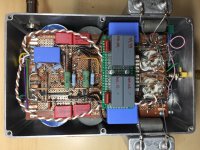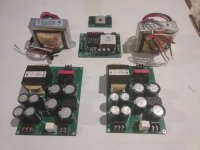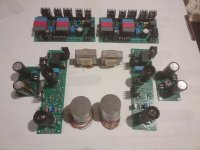d3A CCS will push ~20mA and other two for ECC88, ~10mA each. Disconnect tubes and connect a 10K/5W resistor between cathode and anode. Look on the scope for the noise across resistor.
This should indicate which CCS have problems.
In my case, higher depletion mosfet had problems. For future protection, I have added a zener between upper mosfet gate and lower mosfet source.
Hope this helps.
Regards,
Tibi
This should indicate which CCS have problems.
In my case, higher depletion mosfet had problems. For future protection, I have added a zener between upper mosfet gate and lower mosfet source.
Hope this helps.
Regards,
Tibi
You have excessive colophonium - rosin and this may mask some soldering problems as well. Use isopropyl-alcohol and clean the boards.A better definition pic
Regards,
Tibi
I will follow your advice. Thanks!!!d3A CCS will push ~20mA and other two for ECC88, ~10mA each. Disconnect tubes and connect a 10K/5W resistor between cathode and anode. Look on the scope for the noise across resistor.
This should indicate which CCS have problems.
In my case, higher depletion mosfet had problems. For future protection, I have added a zener between upper mosfet gate and lower mosfet source.
Hope this helps.
Regards,
Tibi
I think you can get better overall performance by using one single dn2540 instead of a cascoded one.Some of the noise might actually be broadband oscillations of the cascoded mosfet as it's very close to Miller plateau and its capacitance changes with current and Vgs unlike a bipolar transistor when cascoded . Even better performance can be achieved by using a kimmel mu-stage topology instead of that current source .
Last edited:
As this thread has been conceived almost twelve years ago, the schematics have vanished from the 1st posting. Is there any chance to see them again?
Best regards!
Best regards!
https://www.yumpu.com/en/document/read/47728837/his-masters-noise-s-yanigerAs this thread has been conceived almost twelve years ago, the schematics have vanished from the 1st posting. Is there any chance to see them again?
Best regards!
Thank you very much!
Well, D3a's may have been in the few bucks range ten years ago. Nowadays they aren't. So, what about paralleling PC 86 UHF frame grid triodes that still are dirt cheap to get this »impressive transconductance« and low plate resistance?
Best regards!
Well, D3a's may have been in the few bucks range ten years ago. Nowadays they aren't. So, what about paralleling PC 86 UHF frame grid triodes that still are dirt cheap to get this »impressive transconductance« and low plate resistance?
Best regards!
I bought 10 siemens d3a 5 years ago for 17 euros/piece from Germany.I could have bought 20 at the time but failed to consider that ...now its about 50 euro/tube...I built two different phono preamps based on d3a, both were my own designs , i was very happy with them , yet many tubes are good enough for phono preamplifiers.I consider d3a somewhat a waste of resources for phono preamps compared to ecc83.About 16...32 times more current and heat than ecc83 for the same job..You still need an input transformer for mc carts no matter what tube you are considering for the job while for mm carts there are lots of tubes good enough for that purposeThank you very much!
Well, D3a's may have been in the few bucks range ten years ago. Nowadays they aren't. So, what about paralleling PC 86 UHF frame grid triodes that still are dirt cheap to get this »impressive transconductance« and low plate resistance?
Best regards!
You waste much of the first stage gain with the passive RIAA network. It's a solution in search of a problem.I bought 10 siemens d3a 5 years ago for 17 euros/piece from Germany.I could have bought 20 at the time but failed to consider that ...now its about 50 euro/pcs...I built two different phono preamps based on d3a, both were my own designs , i was very happy with them , yet many tubes are good enough for phono preamplifiers.I consider d3a somewhat a waste of resources for phono preamps compared to ecc83.About 16...32 times more current and heat than ecc83 for the same job..You still need an input transformer for mc carts no matter what tube you are considering for the job while for mm carts there are lots of tubes good enough for that purpose
That's highly debatable...cause i made lots of very different phono preamps over time and none of them had the sound of the D3A with a passive network and I KNOW it's not because of the nature of the riaa network, but because of the tubes, while having passive or active network with very high GM tubes is completely irrelevant for the noise perspective because they allow one order lower impedance for both passive and active networks. We are already limited by the vinyl surface noise which is at least 10db higher than what a d3a with passive riaa design can get you...Do you think that a phono preamp with 120db SNR would bring you better vinyl experience when vinyl SNR is between 50...70db?You waste much of the first stage gain with the passive RIAA network. It's a solution in search of a problem.
Last edited:
I have two HMN's -- one I managed to fit into a PAS3 chassis!That's highly debatable...cause i made lots of very different phono preamps over time and none of them had the sound of the D3A with a passive network and I KNOW it's not because of the network, but because of the tubes while having passive or active network with very high GM tubes is completely irrelevant for the noise perspective because they allow one order lower impedance for both passive and active networks. We are already limited by the vinyl surface noise which is at least 10db higher than what a d3a with passive riaa design can get you...Do you think that a phono preamp with 120db SNR would bring you better vinyl experience?
Scott Reynolds (www.tavishdesign.com) measured the triode strapped D3a and noise figure relative to 390 Ohms was 5.2dB, about 3dB better than the best 12ax7/ecc83 so your point is well taken. He found that a lower current than SY's was optimal.
I made two preamps based on ecc83, one passive in 2011(about 250k passive network impedance), one active in 2021(Luxman cl 34-clone).Both dead quiet, yet the Luxman clone needed complete and very good shielding with IRON , not the same case with the passive version though which was more resilient to hum .I general I found active versions to be much more prone to hum without careful grounding and shielding.So here's one more point for the passive network.
I made another 2 preamps based on d3a, one in 2014 and one in 2018, both passive.The first one was dead quiet using a version of mu-follower based on ultra-low noise bipolar transistor , the second one had a bit of audible hum as i used a mu-follower based on a very weird topology based on depletion mos-fets(bsp135).When I changed the mu-follover witha very simple design based on irf830 mosfets it became completely quiet. All versions of D3A were run around 16ma , -1...1.2v VGS.I consifered 20ma a bit too much for D3A reliability over time. Never considered to clone HMN...looks silly to me with those cascodes but that's just my opinion..
390 ohms for measuring noise with d3a is unrealistic with a real world mm cartridge.My shure v15type3 measures 1200 ohms at DC if i can remember well.
I made another 2 preamps based on d3a, one in 2014 and one in 2018, both passive.The first one was dead quiet using a version of mu-follower based on ultra-low noise bipolar transistor , the second one had a bit of audible hum as i used a mu-follower based on a very weird topology based on depletion mos-fets(bsp135).When I changed the mu-follover witha very simple design based on irf830 mosfets it became completely quiet. All versions of D3A were run around 16ma , -1...1.2v VGS.I consifered 20ma a bit too much for D3A reliability over time. Never considered to clone HMN...looks silly to me with those cascodes but that's just my opinion..
390 ohms for measuring noise with d3a is unrealistic with a real world mm cartridge.My shure v15type3 measures 1200 ohms at DC if i can remember well.
I have two HMN's -- one I managed to fit into a PAS3 chassis!
Could you post a pic of the interior layout please. I have an old PAS4 collecting dust, which might be an option. TIA
jeff
It's just phono now, will post when I get back to NJ next wkCould you post a pic of the interior layout please. I have an old PAS4 collecting dust, which might be an option. TIA
jeff
Can you tell us more about the various boards?Finally finished my boards. Everything working. Needs final RIAA adjustment. Thanks Jackinnj for the PCB's
@FJCorpes : All I have is an Oscilloscope at home, The power supplies are very quite. Once built I can take it to work and put it on the Spectrum Analyzer.
@Brinkman : The power supple sections consists of split bobbin transformers from Hammond, a PMillett amp switch circuit. It also allows remote on -off and power fo a remote LED. There is a DC blocker. The unregulated sections for the high voltage uses a Tentlabs filter, and an Elliot Sounds bleeder circuit (godsend). For the low voltage, the capacitors are part of an RC filter. The resistors are surface mount a few in parallel to handle current.
For the Audio section: the regulator consists of an RC filter at the HV input, two Maida regulators with a series voltage drop resistor in-between (in one of the heat sinks). The low voltage has an LRC filter at its input. Since this is bipolar I used a common mode inductor. The regulators are the LT1963 and the LT3080, There are ground loop breaker boards but these re optional - don't think I will need them. The audio board is from JackinNJ. I have added sub board with COG/NPO Capacitors in the RIAA. Want to try these. The input transformer is the Sowter 1480 and the output transformer is the Cinemag CMOB-2H
@Brinkman : The power supple sections consists of split bobbin transformers from Hammond, a PMillett amp switch circuit. It also allows remote on -off and power fo a remote LED. There is a DC blocker. The unregulated sections for the high voltage uses a Tentlabs filter, and an Elliot Sounds bleeder circuit (godsend). For the low voltage, the capacitors are part of an RC filter. The resistors are surface mount a few in parallel to handle current.
For the Audio section: the regulator consists of an RC filter at the HV input, two Maida regulators with a series voltage drop resistor in-between (in one of the heat sinks). The low voltage has an LRC filter at its input. Since this is bipolar I used a common mode inductor. The regulators are the LT1963 and the LT3080, There are ground loop breaker boards but these re optional - don't think I will need them. The audio board is from JackinNJ. I have added sub board with COG/NPO Capacitors in the RIAA. Want to try these. The input transformer is the Sowter 1480 and the output transformer is the Cinemag CMOB-2H
Last edited:
Very cool. I’m making the Equal Opportunity phono preamp but with some His Master’s Noise twists (ie Sowter SUT for MC and some DIY adapter boards so I can use two D3A tubes in place of a dual-triode tube). I also picked up a couple Pete Millett boards to help with my build: his regulated DC filament supply PCBs and his 9-pin tube prototype boards (to make the adapters mentioned above).
I’m having trouble finding the Millett switch circuit. Is there any way I can ask you nicely (please) for some links?
I’m having trouble finding the Millett switch circuit. Is there any way I can ask you nicely (please) for some links?
- Home
- General Interest
- diyAudio.com Articles
- His Master's Noise: A Thoroughly Modern Tube Phono Preamp


